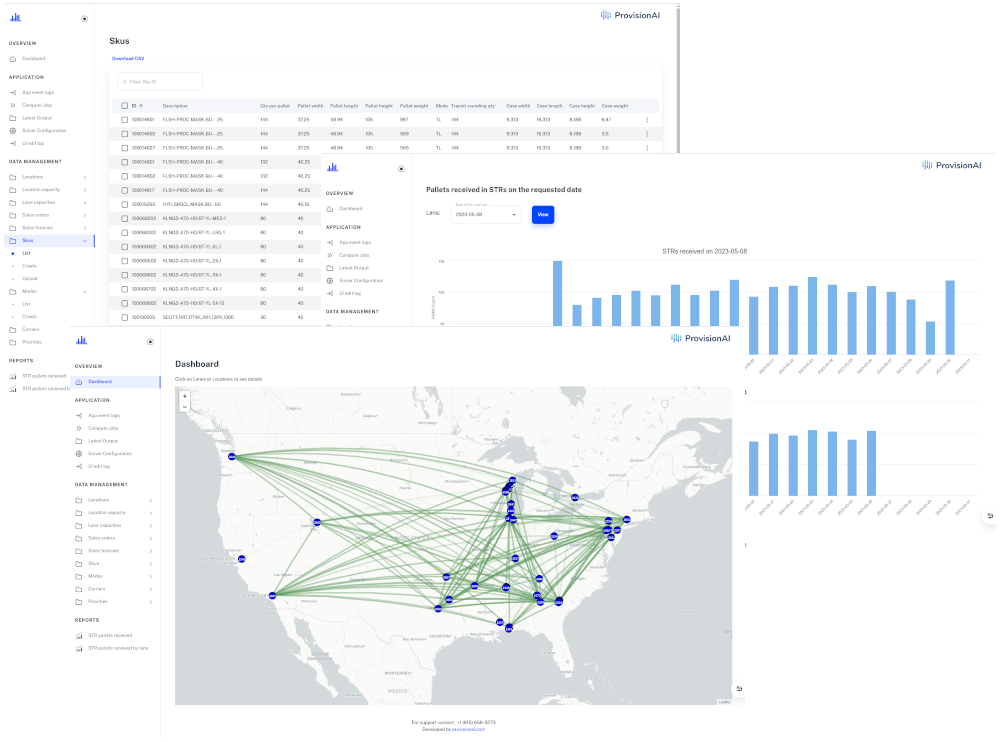
We proudly present an innovative deployment transportation scheduler, LevelLoad, that cuts transportation costs by eliminating volatility.
Filling the gap between supply-planning and execution systems, LevelLoad is an essential component of supply-chain excellence. LevelLoad uses Automatic Order Optimization (AutoO2) load building optimization to create legal and efficient shipments that fill more trailers.
Deployment volatility and the associated high costs
Fluctuations in volume (volatility) have always been a part of all supply-chain networks. Customer orders are volatile, and that drives volatility in inventory deployment. Moreover, the replenishment movements of products from plants or suppliers to market-facing distribution centers could be more balanced. The following paragraphs outline the cost impacts and effective ways to mitigate them.
Deployment volatility generates excess cost
If only everything were calm and smooth – but it isn’t. Instead, deployment volumes on any lane (origin-destination-mode) vary significantly day-to-day. It generates a considerable number of bad outcomes:
• Best (preferred) carriers may be unable to handle peak volume, so some shipments may need to be shifted to higher-cost, less reliable truckers.
• Both shipping and receiving locations may become inundated with volume and unable to ship or receive without substantial overtime labor. It is worse in the receiving location because a tsunami of volume from several uncoordinated ship points arrives simultaneously.
Drowning in this volume can generate detention and potentially strand needed inventory in a queue of trucks waiting to unload. The impact on a critical measure called OTIF (on-time, In full) can create significant chargebacks. Constraining deployment alone to match capacity is insufficient in customer-facing distribution sites. In these sites, customer volume typically takes precedence, and it, too, must be accounted for when trying to constrain site throughput to match capacity.
• While the dock is a constraint on throughput, the lack of storage space can also adversely impact unloading. Often, this generates significant service failures as much-needed product waits in trailers and trailers wait to unload.

Supply-planning systems may exacerbate supply-chain volatility
Supply-planning systems typically react to customer needs unpredictably, creating much supply-chain volatility. That is, the volatility in the number of deployment stock transfer orders (STOs) each day is a reaction of the supply-planning system to customer orders and changes in safety stock generated to mitigate this volatility. Furthermore, because supply-planning systems have limited capability to consider transportation costs and preferred carrier availability over time holistically, the supply signal tends to be problematic. So, supply panning can create self-inflicted wounds.
Additionally, we know of no supply planning systems that actively manage site volume throughput. Managing the throughput of receiving locations is particularly complex because the receiving volume comprises shipments with varying transit times based on shipping location and mode. In summary, most (all) planning systems don’t manage volatility and throughput, and their reactions to customer variability may amplify volatility. When you add to these shortcomings the need for more understanding of site-space constraints, the picture develops of a significant and expensive problem caused by the gap between supply-chain planning systems and execution.

LevelLoad and AutoO2 bridge the gap between planning and execution to cut costs while maintaining service
LevelLoad, a SaaS-based replenishment transportation scheduler, has proven effective in smoothing deployment volatility. Together with AutoO2, an optimizing load builder, they can perform the needed smoothing and postponement.
Here is how it works
When the supply planning system runs, it sends the latest requirements and other data, like forecasts and production, to LevelLoad. It is augmented with data from the ERP of existing orders, inventory, and previously positioned reservations of carrier capacity.
It enables LevelLoad to generate a plan for a period of time, usually, ~30 days, constrained by site space and throughput capacity while maximizing the deployment of high-priority deployments.
LevelLoad uses fast-linear programming techniques combined with an ultrafast AI-enabled (reinforcement learning) load builder that simulates the contents of future loads. LevelLoad iterates between the linear program and the load builder to identify what trucks need to be scheduled to move which products are on which lanes.
It quickly settles on a plan even for large networks and creates the required signal for the TMS (Transportation Management System) to perform early tendering. It is often done at night and can be completely autonomous.
Final phase
Closer to the shipment date, generally, the day before the load shipment, AutoO2 (an optimizing load builder that considers many more factors than LevelLoad) takes the latest requirements information from the supply planning system. With this data and information about how many loads have been scheduled by the LevelLoad process run days earlier, AutoO2 determines what should ship on each vehicle.
Thus, each of the tenders initiated by LevelLoad, is filled with the highest-priority, most-needed product.
Using load builder AutoO2 ultimately loads all ships – no wasted capacity in either cube or weight.
AutoO2 features
• Because the deployment transportation scheduler LevelLoad knows the carrier in advance, loads are tailored to utilize that specific carrier’s equipment. For example, AutoO2 uses a carrier with lightweight trucks and provides instructions to load it heavier than a “standard” hauler.
• Importantly, AutoO2 shows the placement of each pallet on the load and, if needed, each picked case. This way, the shipping site can be sure the load will be legal and arrive damage-free.
We would be glad to share the results with you.
Cut site volatility by shifting limited capacity between lanes
As mentioned earlier, managing site throughput and storage capacity is equally crucial to managing lane volumes. Generally speaking, when making daily deployment decisions, the requirements on any lane range from the high-priority, most-needed demand to lower-priority needs. And some deployment lanes will likely require many more high-priority replenishments than others. Therefore, replenishment transportation scheduling systems need to use the preponderance of priority requirements to favor volume on one lane over another on any given day while setting the total site volume to within capability limits.
Reduce the amount of higher-cost freight by tendering earlier
Tendering deployment loads early (as many companies do) can create problems if it ties the tendering of trucks to the definition of what is on each load. The problem is that the further in advance you determine what items to replenish, the less likely it is to be correct. But, because, for the most part, carriers don’t need to know what is on the load, it’s possible to reserve trucking capacity without specifying what will go inside the trailer. In addition, the determination “later” allows the planning system to have more information in the form of orders and inventories, thus enabling a more accurate determination of the priority of need at any customer-facing distribution site.
This postponement strategy generates the following results:
• Increased lead time for the carrier because they still receive the tenders early and “first tender acceptance,” – meaning the “most favored carrier” takes the load.
• Better tailored of actual stock-transfer orders (STOs) because the contents are specified as late as possible.